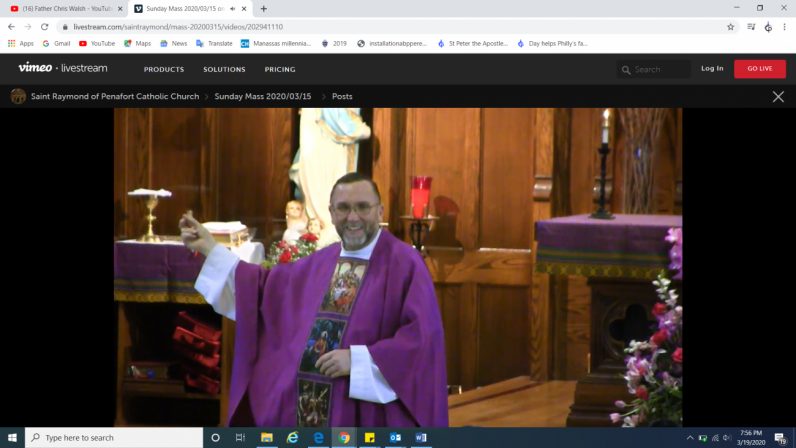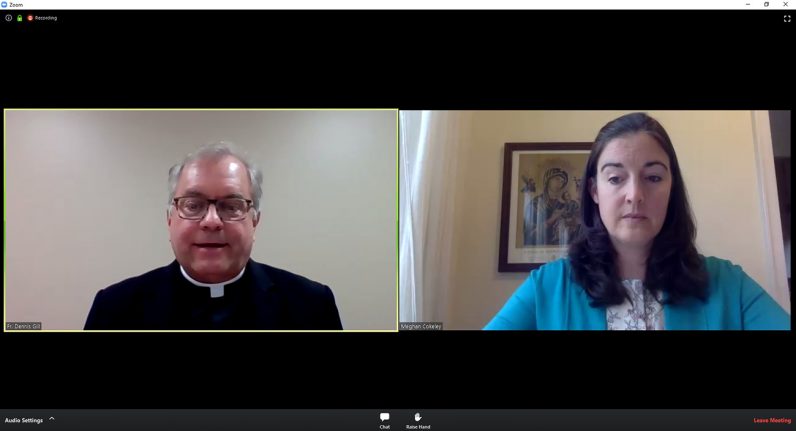
Father Christopher Walsh, pastor of St. Raymond Parish in Philadelphia, celebrates a March 15, 2020 livestreamed liturgy. The Archdiocese of Philadelphia is now exploring how parishes can eventually resume public Masses as state health officials are lifting COVID-19 restrictions in a three-phased, county-by-county approach. (Image courtesy of St. Raymond of Penafort Parish / Maria Pisano)
As state officials begin to ease COVID-19 restrictions, the Philadelphia Archdiocese is exploring how parishes can eventually resume the celebration of public liturgies.
Father Dennis Gill, director of the archdiocesan Office for Divine Worship, broadly outlined the plans – many of which are still under development – in a May 6 webinar with archdiocesan pastors and parish leaders.
The webinar was part of “Arise: Restoring Catholic Life after the Pandemic,” a multifaceted effort to transition the archdiocese to active, in-person participation in Masses and parish activities after months of social distancing to prevent the spread of the virus. The project is being spearheaded by a task force recently convened by Archbishop Nelson Perez.
[hotblock]
Father Gill, who co-chairs the task force with archdiocesan evangelization director Meghan Cokeley, said that preparations for post-pandemic life should cultivate a “new zeal” and a deeper appreciation of the sacraments.
(Related: Archdiocese plans for renewal of parish life after pandemic)
He acknowledged the “great sadness and discouragement” experienced by many at the inability to attend Mass in person and to receive holy Communion, adding that it has been “not only … a hardship, but crippling.”
At the same time, he stressed that clergy and faithful will need to “cooperate with one another” as the archdiocese navigates the transition period in alignment with public health officials.
“It is really important that we don’t work against each other or disrespect what others are trying to do” to mitigate the coronavirus, he said.
The clarification was intended to counter an impression that the archdiocese “has been trailing the state and medical professionals” in its response to the coronavirus, said Father Gill, noting that faith and public health directives are not in opposition.
“We have been listening to … and cooperating with the state, and we need the guidance of professionals,” he said, adding that ultimately “the church leads” in its plans to restore in-person public worship.
Updates will be issued by the archdiocese as the state’s strategy evolves, and “it will be the Archbishop himself who will direct us that it’s time for us to open things,” Father Gill said.
The hour-long webinar, during which Father Gill and co-host Cokeley fielded more than 30 questions, affirmed that parish life will continue to be profoundly impacted by the pandemic in the weeks and months ahead – requiring patience, creativity and hope on all sides.
Three phases to a ‘new normal’
The archdiocesan shift to post-pandemic activity will mirror the state’s three-stage plan for resuming business and public activities, said Father Gill.
(Related: Strong communications key to restoring parish life after COVID-19)
For weeks, Pennsylvania has been in the “red phase,” which mandates stay-at-home orders, strict social distancing, and the closures of school and non-life sustaining businesses.
Effective May 8, Pennsylvania Governor Tom Wolf will lift some of the current restrictions in 24 counties in the state’s northwest and north-central regions, where the number of infections has been comparatively lower.

In a May 6 webinar with area clergy and pastoral leaders, Father Dennis Gill, director of the archdiocesan Office for Divine Worship, and Meghan Cokeley, director of the archdiocesan Office for the New Evangelization, surveyed some next steps in restoring public Masses as COVID-19 restrictions are gradually lifted. The presentation is part of the an archdiocesan post-pandemic transition initiative of which Father Gill and Cokeley are co-chairs. (Image courtesy of the Archdiocese of Philadelphia / Gina Christian)
Even after this “yellow” period, the final “green” stage will mark what the state calls a “new normal” in which Centers for Disease Control (CDC) and Pennsylvania Department of Health guidelines must be observed.
Given its COVID-19 statistics and population density, the five-county archdiocesan area will likely be among the last to emerge from the red phase, with the very real possibility that “one county may move ahead of another” in reopening, said Father Gill.
Sanitation, social distancing will remain vital
Admitting that “it’s very hard to say … precisely” what the next two phases might look like in parishes, Father Gill confirmed that both sanitation and social distancing will be key to preventing a resurgence of COVID-19.
He stated that churches will need to be regularly disinfected according to CDC guidelines. Baptismal fonts are to be cleaned after every celebration and fresh water to be used for every baptism. Clergy and faithful should wash their hands with soap and water before and after the liturgy, he said.
At present, daily and Sunday Masses celebrated on a non-public basis — along with weddings, funerals and baptisms — cannot exceed a total of 10 people, including the celebrant and the liturgical ministers.
[tower]
Although social distancing is important, said Father Gill, “it’s meant to be reasonable.”
He observed that the practice “is creating an unnatural way for people to interact,” and said that “while we have to respect these norms … the liturgy cannot become subject to some type of robotic interaction.”
Gatherings will be limited to 25 under the Pennsylvania’s yellow phase, but Father Gill said there are “some conversations on the state level about that number.”
He indicated it might instead make more sense to “look at the percentage of persons versus the space” so that large buildings such as churches could accommodate more people and still comply with social distancing norms.
The question of how to regulate the number of attendees at a public liturgy is still “under study,” he said.
The church “cannot forbid the reception of holy Communion on the tongue,” said Father Gill, but “may recommend” that the sacrament “be received on the hand at this point.”
Reception of the Precious Blood “will probably be suspended for the forseeable future,” he conceded, but “that certainly is not a permanent restriction.”
The use of face masks and gloves, and at least a temporary discontinuation of handing out printed materials such as hymnals and church bulletins, is being considered, said Father Gill.
He encouraged parishes to continue with livestreamed Masses, which have helped sustain active parishioners amid the pandemic while attracting thousands who do not ordinarily attend in-person liturgies.
As with the Sunday Mass obligation, the faithful have been dispensed from the holy day obligation for the Ascension of the Lord on May 21, Father Gill said. The Mass celebrated that day at the Cathedral Basilica of SS. Peter and Paul will be livestreamed.
It is still “too soon to tell” if there will be restrictions on the number of attendees at Masses for the sacraments of first holy Communion and confirmation in the fall, he said.
However, a Eucharistic Congress to be hosted by the archdiocese on October 9 and 10 will proceed, although Father Gill said he is “not exactly sure what (it) will look like post-COVID-19.”
Holy oils consecrated during the Chrism Mass at the Cathedral will be provided “before the end of Easter time” to the archdiocesan deaneries for collection by pastors, he said.
Faith in creative ways
To assist parishes in emerging from the pandemic, the nonprofit Catholic Leadership Institute (CLI) will offer “free leadership counseling to all archdiocesan pastors,” said Father Gill, with details to be shared in a May 13 webinar that can be accessed through the Arise website.
Despite the frustrations and challenges incurred by the pandemic and its suspension of public liturgies, “this is not the first time the church has been through something like this,” said Father Gill.
He cited the example of St. Charles Borromeo, who as bishop of Milan during a 16th-century plague “made himself available in new, different, powerful and creative ways.”
Similarly, Mother Mary Teresa Tallon, foundress of the Parish Visitors of Mary Immaculate religious order, “made every soul count” regardless of limited circumstances, said Father Gill.
“Saints are in the making right now,” he said. “There are new St. Charles Borromeos and Mother Mary Teresa Tallons out there, and that includes us.”
***
For more information on “Arise: Restoring Catholic Life after the Pandemic,” visit archphila.org/arise.
PREVIOUS: Even with payouts for abuse victims, archdiocese’s finances improve
NEXT: New video series explores power of Christ to restore life after COVID-19



Share this story